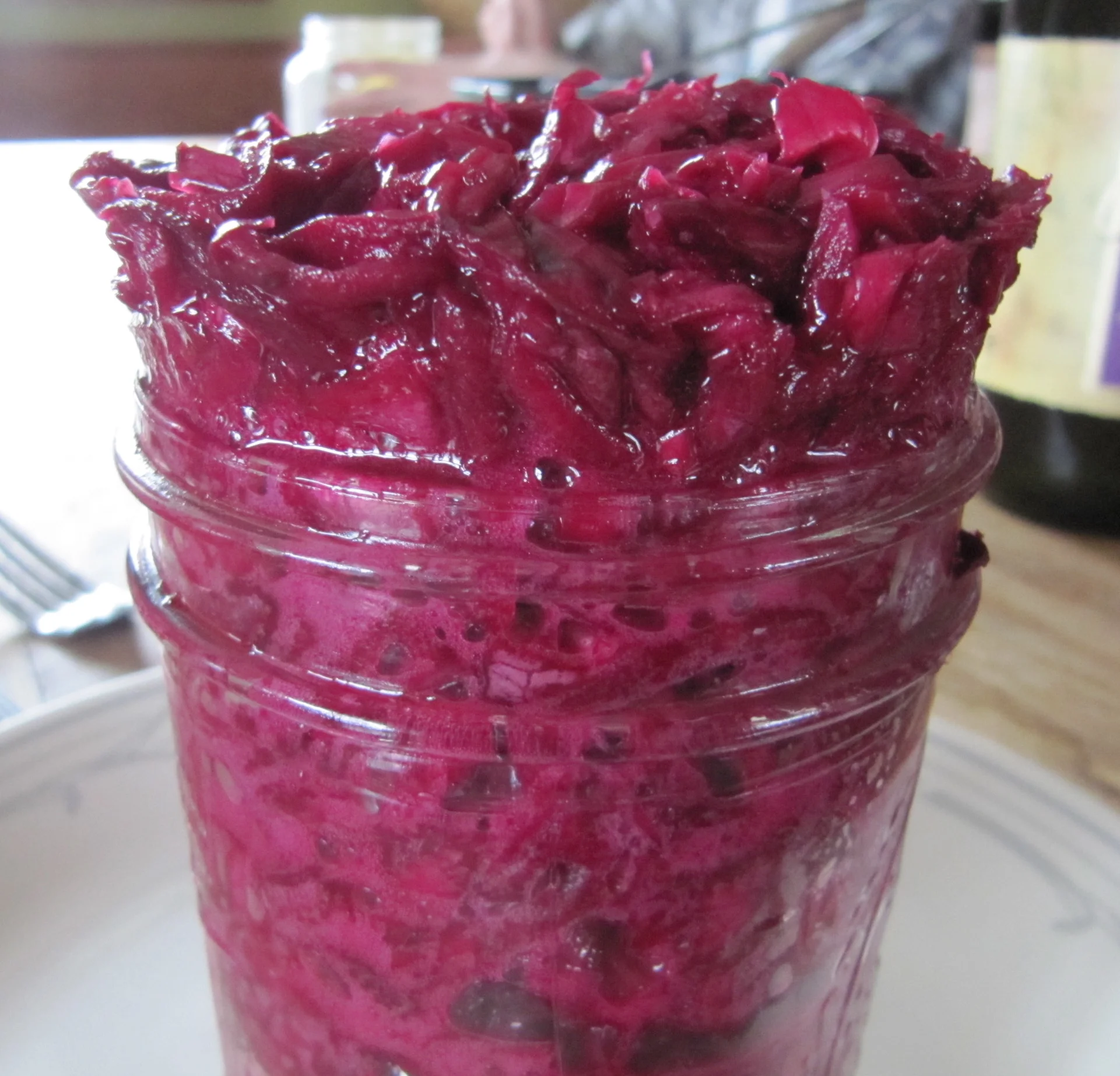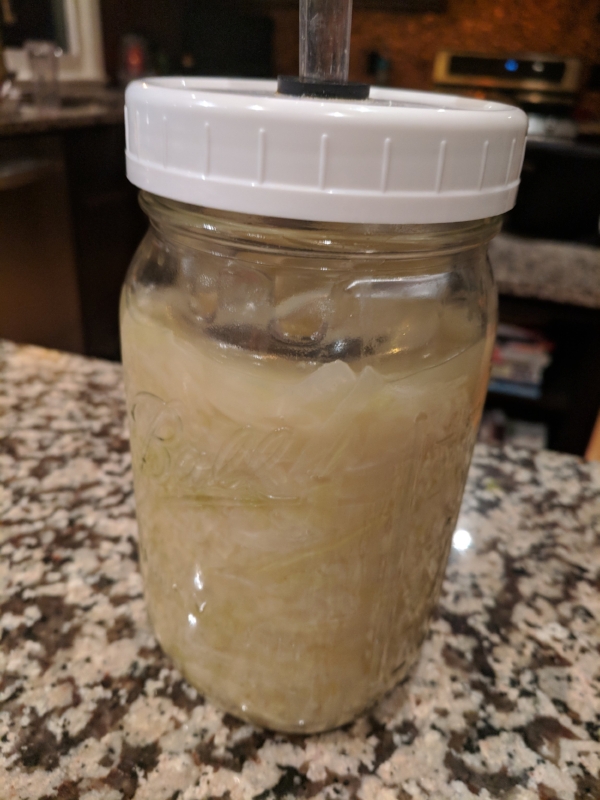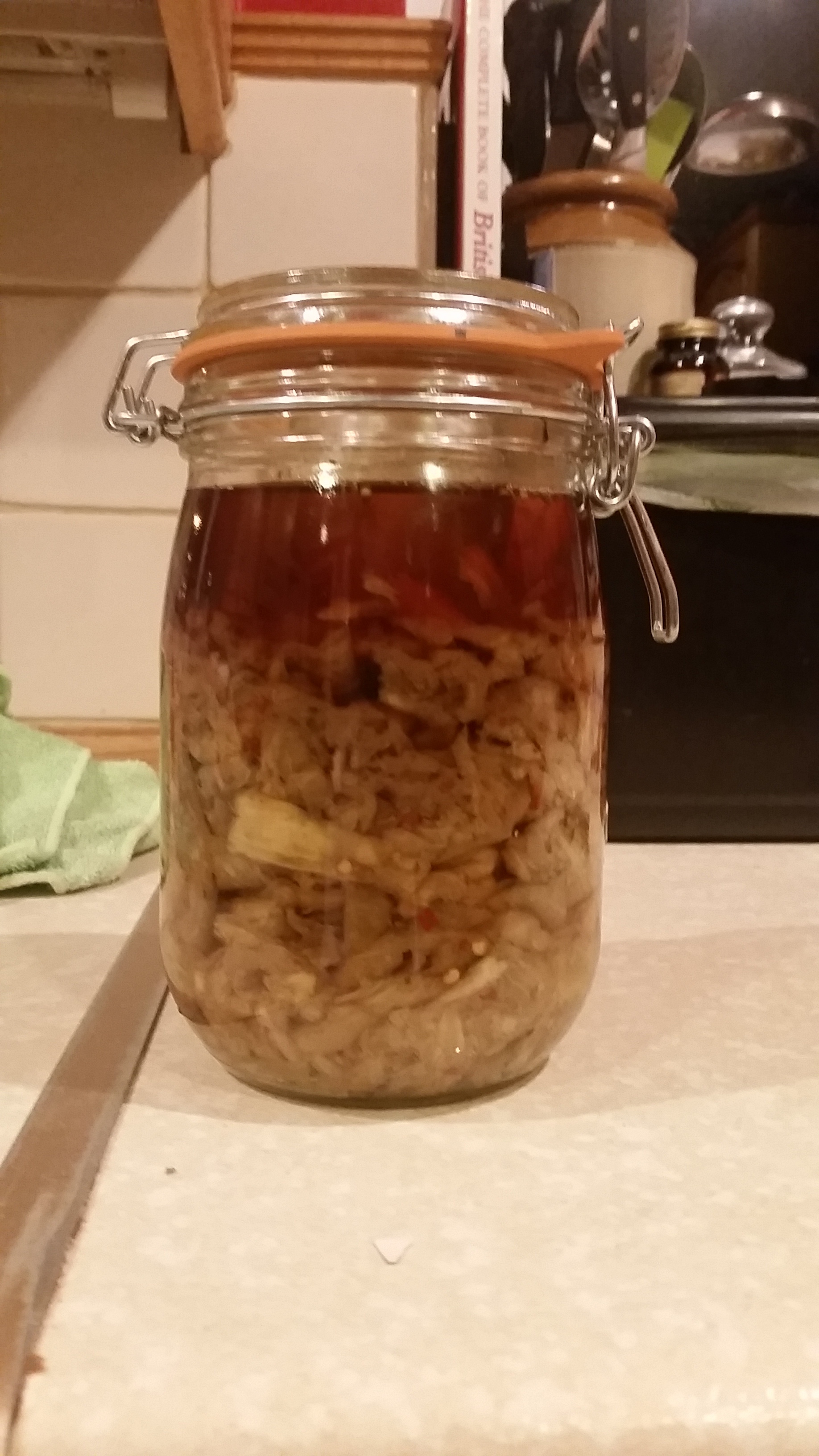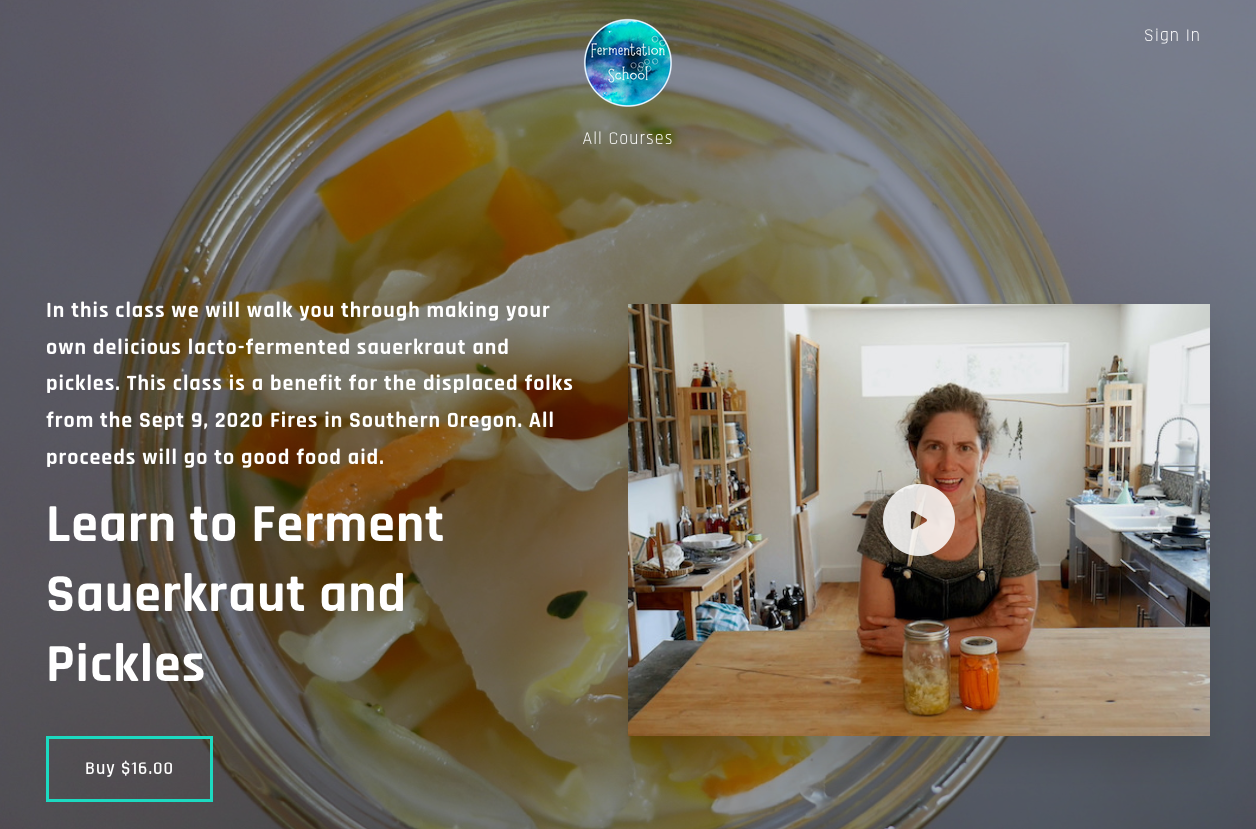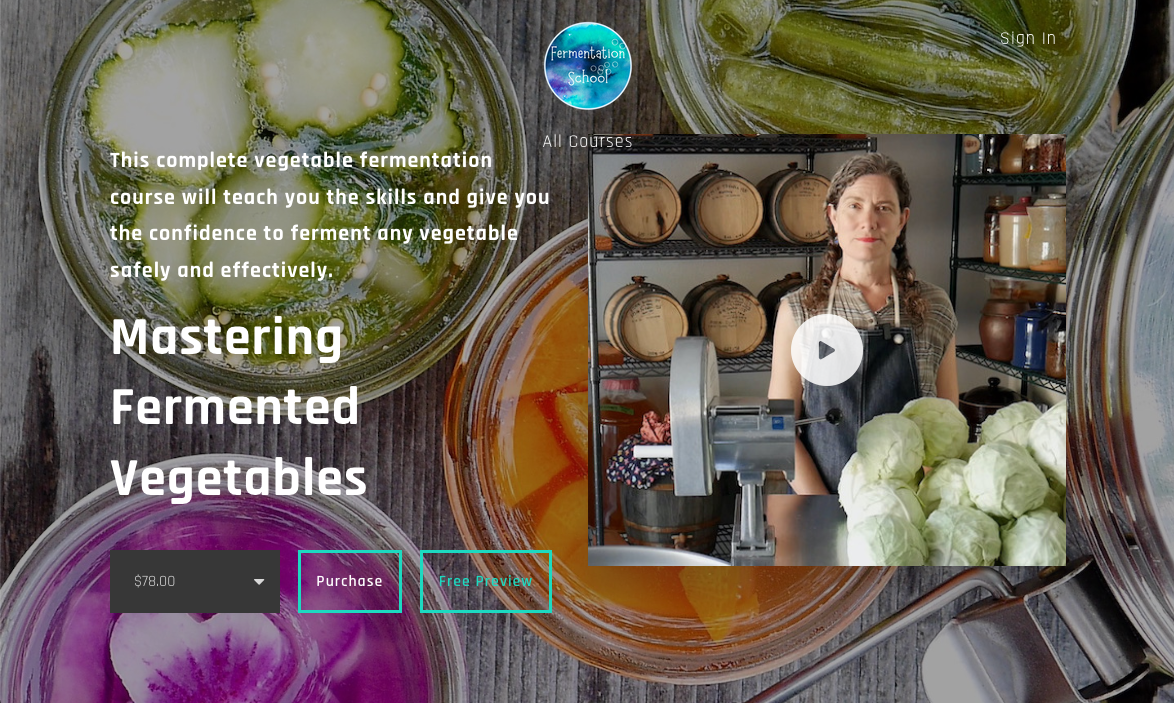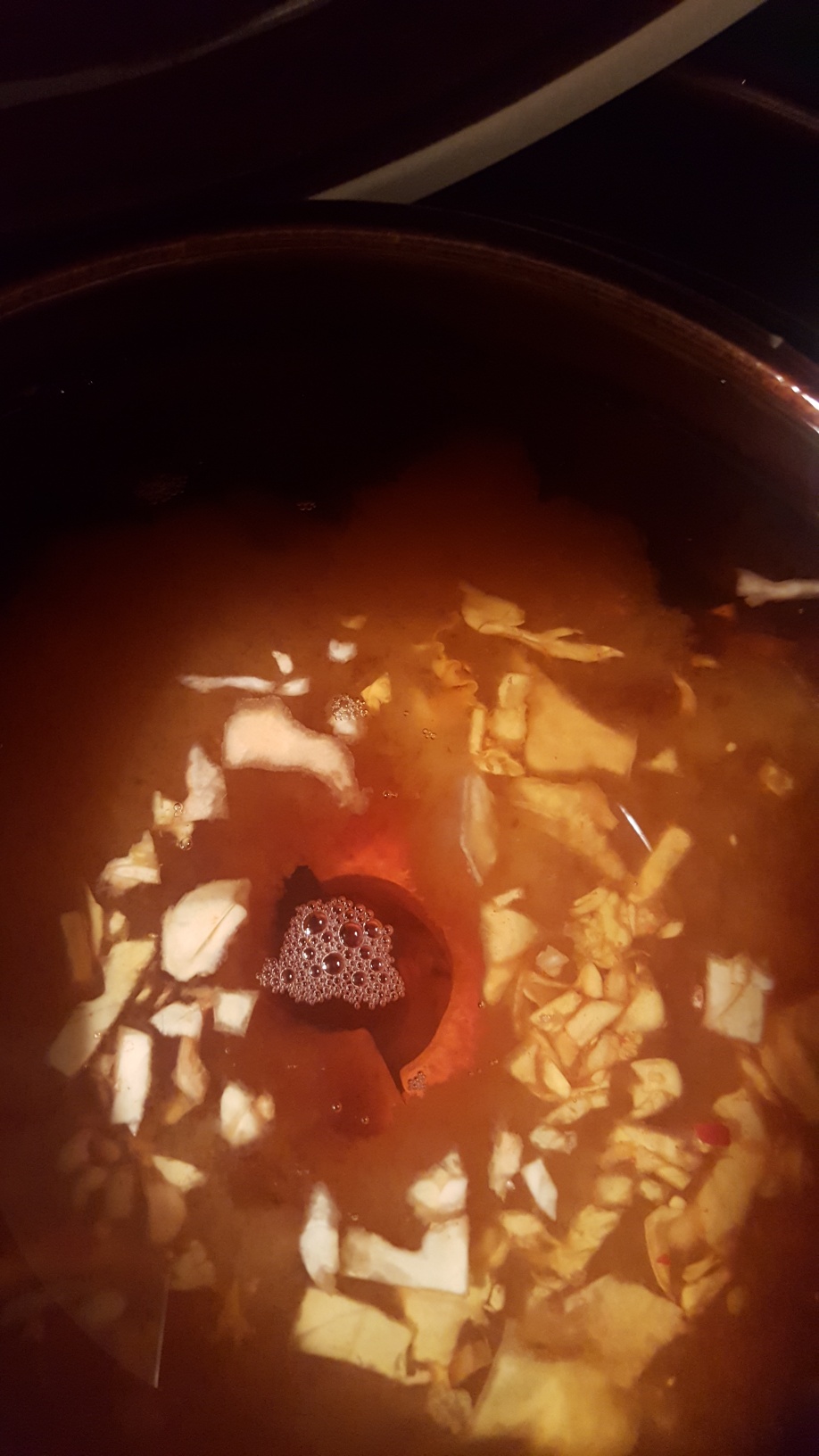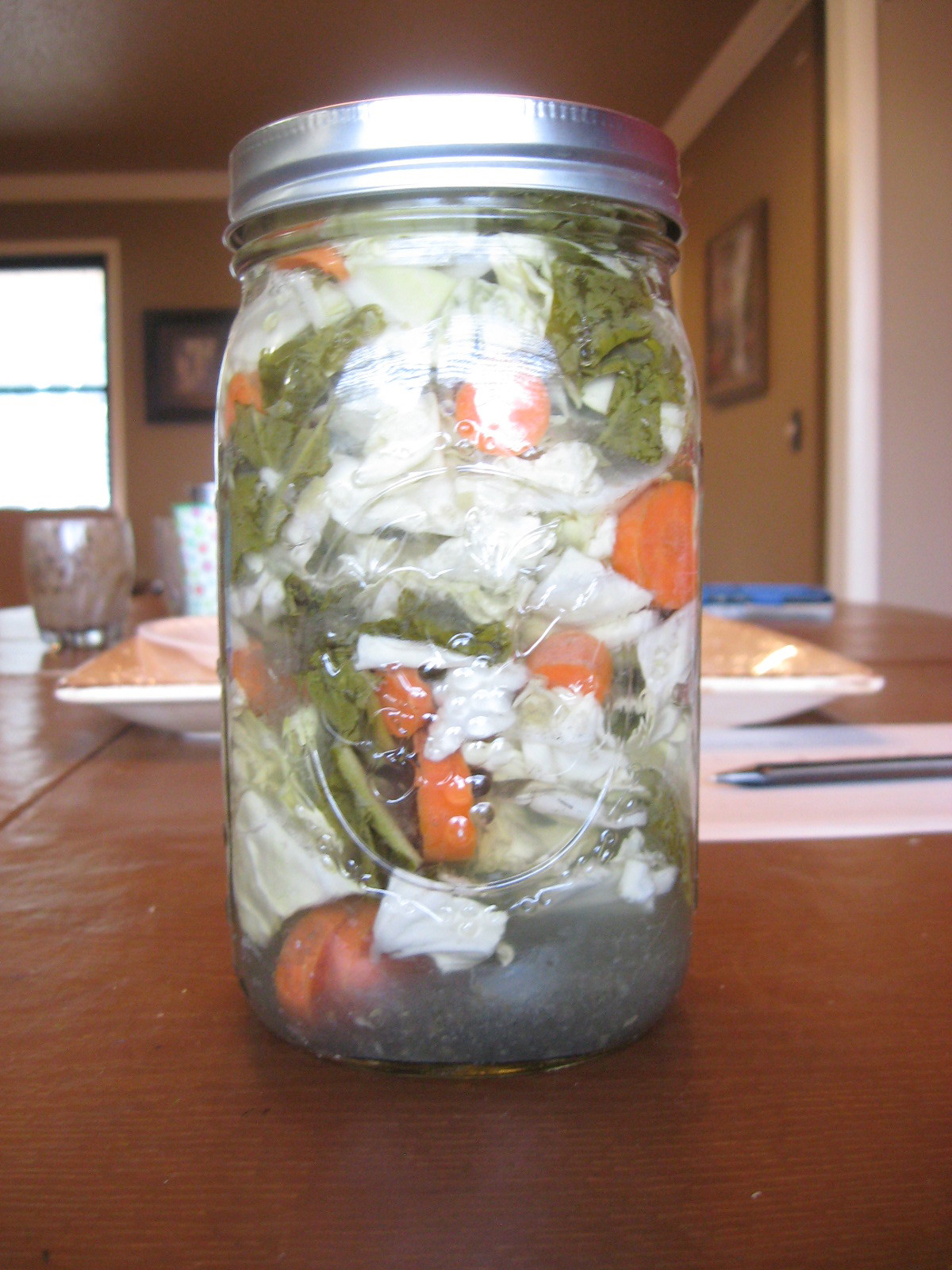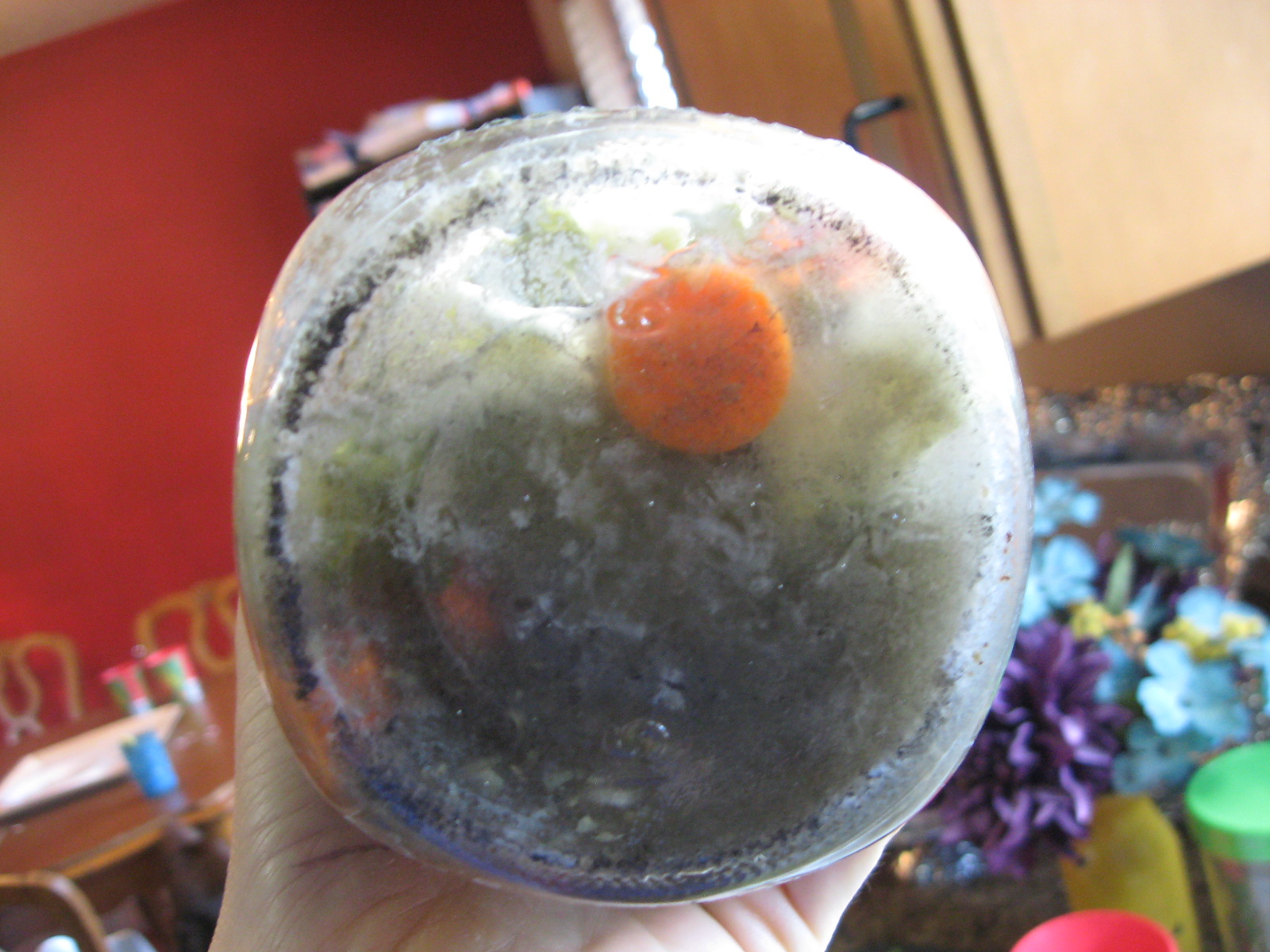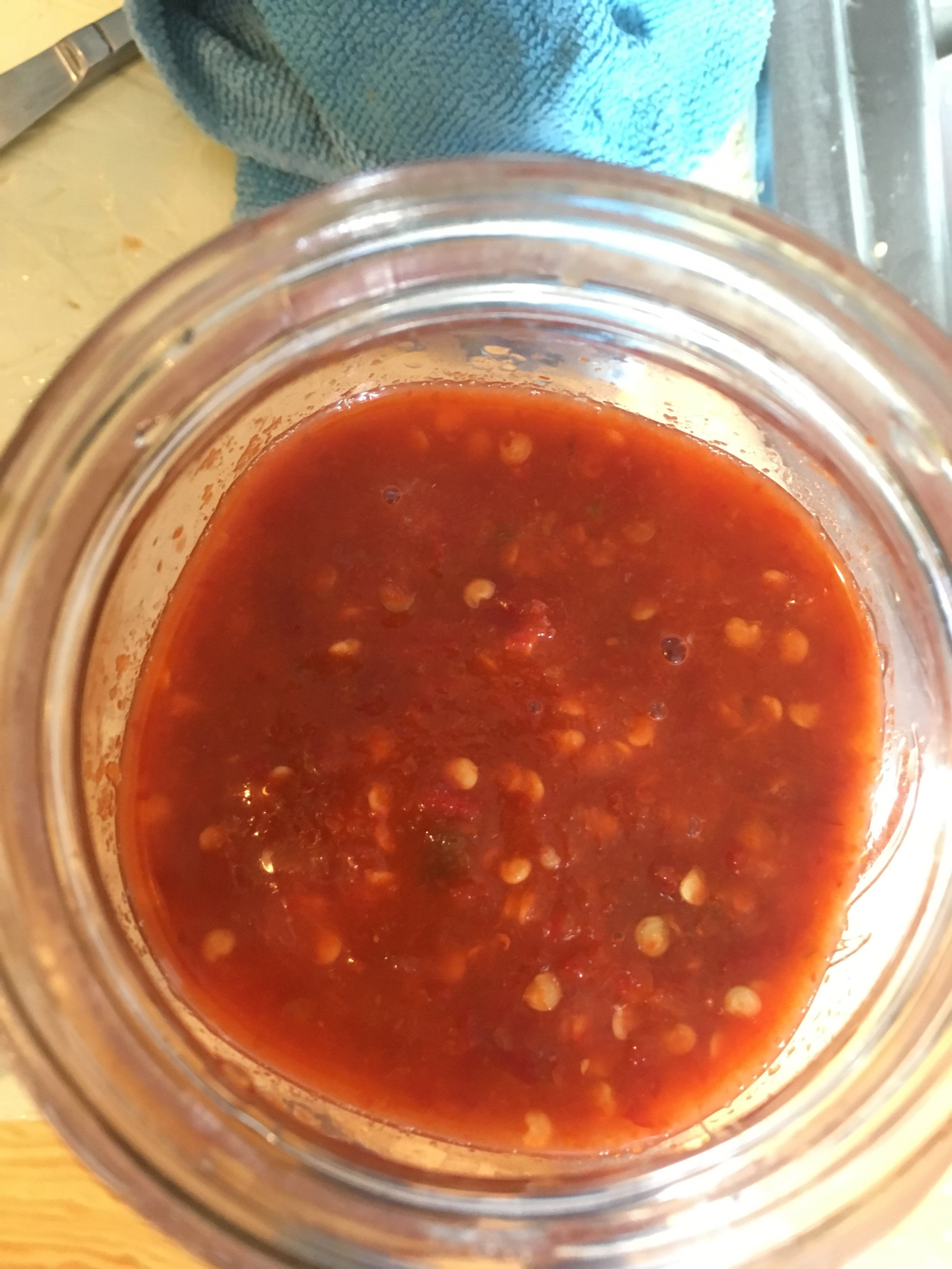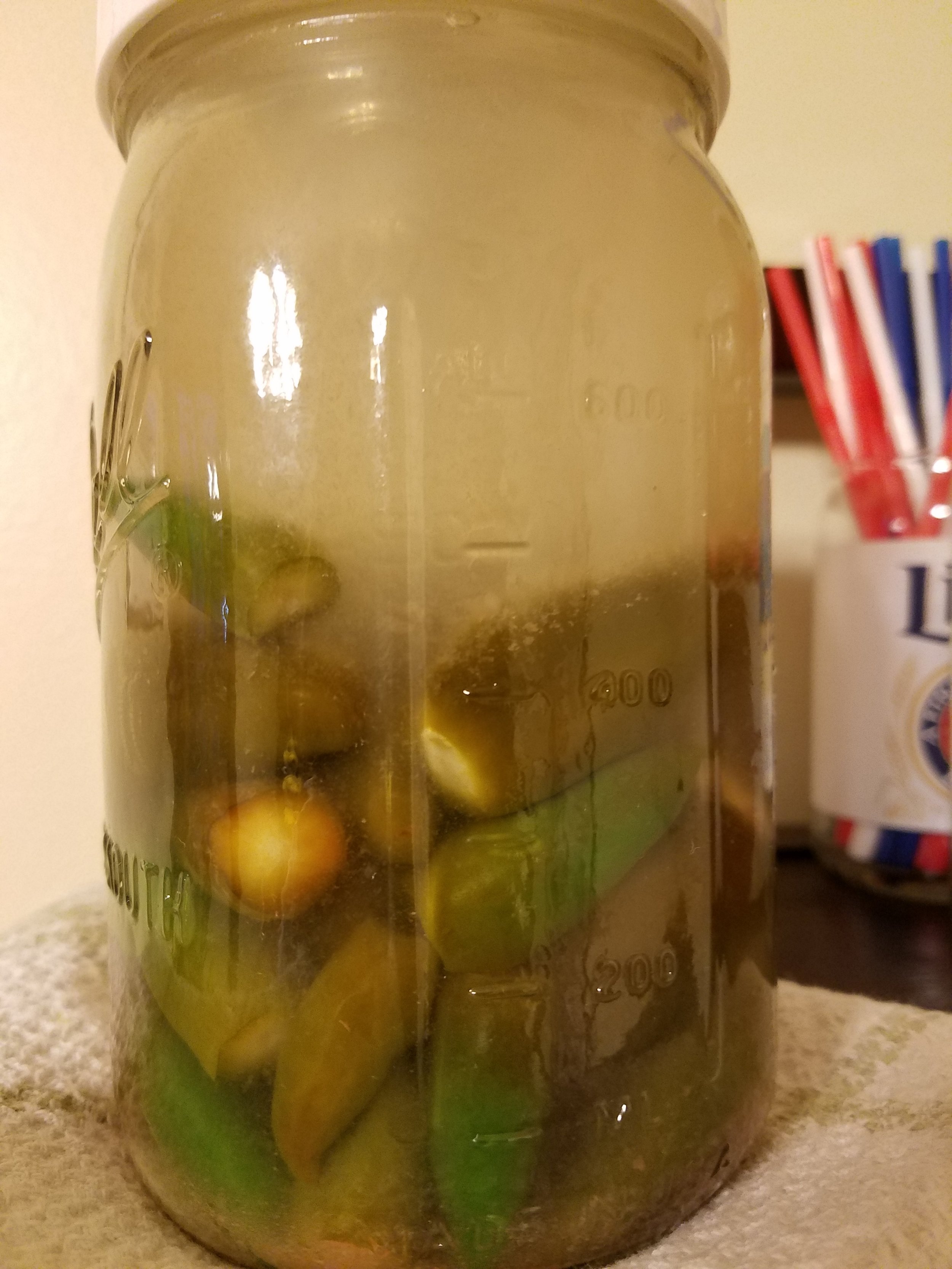Good evening,
I came across your page while worrying about my first ever batch of lacto fermented hot sauce. I've never fermented anything before, so i'd rather be on the safe than sorry side of foodborne illness. When starting, the ferment had tiny bubbles during the first week. The directions I followed stated to massage the peppers after a week, so I opened it up to do so. Other than that, I haven't touched it in 5 weeks. That 1 week mark was also the time, however, that it stopped producing bubbles. Do you mind just letting me know if it looks okay? No bad smell, just a lot of sediment/debris and no bubbles. These are red and green jalapenos along with onions and then spices.
Thank youCasey
**************
Hello Casey,
Thanks for contacting us and sending photos. We have never heard of the massage at the 1 week technique and can’t think of why that would be suggested. Maybe the author had an issue with whole peppers not getting the brine inside them so they thought they should me massaged? Don’t know but I would suggest leaving that off your next batch process, you really should not need nor want to handle the ferments while they are fermenting. Opening the lid also releases the protective CO2 layer that should be captured under the lid and water in your air lock. Is there water in your air lock on top of the lid?
On to good news - they look fine. That sediment you see is normal. I would suggest spooning some out and tasting. If you like then you might think about spooning all the vegetables into your blender and adding ¼ of the brine you think you will use and blend. Check the consistency and keep adding brine until you get to the sauciness you are imagining.
Let us know how it goes Casey.Cheers
Christopher
What Causes The Milky Sediment At The Bottom Of My Ferment?
Three weeks ago I jumped into fermenting with both feet. I fermented 10 jars of various vegetables. 3 weeks into it they are getting tasty. Three jars were peppers from my garden. About a week in I noticed two of the jars of peppers have this milky sediment on the bottom. I used the same brine and added only garlic to all three. All three still smell and taste great so I suspect that it’s safe but it looks nasty. Do you have any idea what’s going on here?
Thanks for your help.
Charles
******************
Hi Charles,
Nice to hear from you and that you have thrown yourself into fermentation.
The good news is this is perfectly normal, in fact all ferments have this sediment! It is actually a sign that everything has gone well. If you are curious look under the jars of Bubbies pickles in the grocery store and you will see the same sediment and the cloudy brine.
Keep on fermenting!
Kirsten
Embrace the sediment and the flavors of fermented peppers! Jump to some Fiery Ferment’s related blog posts , pick up a copy of Fiery or get on signed to you by us, or you can take a class from Kirsten, at your own pace and right in your own kitchen, garden, or anywhere you happen to find yourself wanting to ferment some peppers.
Student Reviews:
If you are looking for accurate information about making your own hot sauces, this is the class for you. Christopher and Kirsten share their wealth of knowledge in a way that is valuable for the novice as well as for those who are already experienced. - Gay DeJong
What Is The White Film That Can Develop On Fermented Onions?
Hello,
I am so glad I came across your website. I have a batch of red onion ferment I am not sure is safe to try. I have quite a bit of experience with kimchi, but this is the first time I have tried fermenting onion. The recipe was just onion and salt, and the onions were supposed to give enough juice to keep them covered, but they did not and so the top layer was exposed to air. They were fermenting for about 2 weeks at about 19 degrees C. A layer of white film developed on top of the onions. It smells like fresh yeast. I have never had this issue before. Any idea what is it, and is the onion safe to consume? Thanks so much,Magdalena Denenberg
***********************
Hello Magdalena,
Glad you found the site before you tossed the onions—they should be tasty. You are correct in that the film developed due to onions on that weren’t fully submerged under the brine. The is kahm yeast, harmless but not so tasty. You will want to scoop off this top layer and then the rest will be fine. I also suggest putting the good part in a smaller jar now that it is ready to refrigerate. Less air in the jar makes it less likely that you will see a film like this this.
Happy to help.
Enjoy the onions,
Kirsten
How Long Should Naked Kraut Ferment?
Greetings!!
I followed the book “fermented vegetables” and it seemed my ferment was ready at five days.
I didn’t want it too sour/“nasty” (my husband and a dear friend were skeptical at letting it sit too long) so i tasted it and jarred it up. it’s in the fridge. My first kraut. Naked kraut.
Do you think I rushed it?
We keep our house at 65F year round and i had this in a crock in my sewing room above our boiler room.
Thank you!!!!***********************
Hi there,
Congratulations on your first Naked Kraut. Sorry for the slowish response. We have been traveling a lot. These look great. I am guessing you are enjoying them by now. As soon as the kraut smells pickley then it is technically done. As the time increases it just gets more sour. The only reason to let it go more is that it will continue to process the carbohydrates and “predigest” them for you. That said these younger ferments are super tasty and still good for you.
Enjoy,
Kirsten
How Much Brine Should Curried Cauliflower Have?
Hi Kirsten & Christopher,
I've been enjoying your book, "Fermented Vegetables." I picked up a copy at a
Story Publishing sale this summer. I've made some great pickles and Edgy Vegetables.
I'm writing because I'm having a problem with your Curried Cauliflower recipe. I've followed the recipe and it's in a Gallon Jar with glass weights and a fermentation lid as you can see. The problem is that it's not making much liquid. I added about 1.75 teaspoons of salt when I made it and after 12 hours there was just maybe an inch of liquid. It's definitely reduced in size a few inches. I took out the contents and added another teaspoon of salt and put it back in the jar. But I'm still not seeing much liquid after another 4 or 5 hours.
Can you help me? Should I make a brine and add it? The cauliflower is a head that I grew and picked a few days ago, so it's pretty fresh.
Thanks,
Charley
***********************
Hi Charley,
Hmmm. I wonder if you have more liquid now. Usually this is not an issue when the cauliflower is thinly sliced. It looks like your cauliflower and veggies are all plenty small. A good massage or pressing tightly also helps release the liquid. Problem is sometimes the veggies are just abnormally dry. I, of course, don’t know if that is what is going on but could be.
You need just enough brine to keep things anaerobic with no air pockets.
What to do from here? If you now have enough—great. If not you could add a low salt water solution. Not my favorite but will save the batch. It sounds like you already have a bit of salt. The solution I’m thinking is 1 tablespoon per pint of water. I would say if you put in two teaspoons already then only make the brine with two teaspoons instead of the full tablespoon.
Another trick when you don’t have enough brine is to squeeze the juice of a lemon, or other citrus. Adding citrus can solve low brine and give nice flavors.
Hope that helps.
Kirsten
Is Brown Fermented Garlic Paste Normal?
Garlic Paste
Hi Christopher and Kirsten,
I am loving trying all the different ferments from your book, and mostly have had success! This year I had a bumper crop of garlic, and a lot of patience. I Followed the directions for garlic paste. It has been sitting now for 2 weeks, and is starting to turn a brown color. When I took the bag and plastic out, I scooped some out. It smells like garlic! I am worried about the brown. Is this normal? Also on related garlic, is it supposed to kind of turn translucent? I don't worry so much about the liquid ones, I know they are under the brine, and are fine : ).
Thanks!
Candace*************************
Hi Candace,
We love that you are enjoying our book. Your garlic paste looks perfect! (Which is good news given that looks like a 1/2 gallon jar—I know how much work went into that?) You can add it to your success list.
The browning is the sugars caramelizing and is exactly the color it should be.
As far as the translucent — do you mean the ones up high on the side of the jar — those looks discolored. I would always wipe off the lonely stuff on the sides but everything looks pretty perfect to me.
The main thing you will want to do is store in smaller containers with little airspace.
Hope that helps,
Kirsten
Cabbage Leaves Blackening?
Hi.
I am making sour cabbage leaves for cabbage rolls and using old Baba recipe which is very loosely-goose as to amount of salt and water. Smells like they are fermenting but outer leaves appear to be blackening! Yikes! Why? And are they still salvageable?
Thanks, Kathy
*********************
HI Kathy,
These look okay to me, I don’t see they “blackening” but I do see the deep color I think you are referring to, this is just the color that the greener outer leaves get. Think of the color of an olive or dill pickle. Green turns that army style green.
I think as long as you keep them submerged until they are fully fermented they will be fine.
I hope that helps,
Kirsten
Different Color in Pickles?
Hi there,
Wondering what’s up with the color difference on my lacto ferment pickles. Same batch, one has a light green band around the outside, and the other is fully dark green all the way to the skin.
Thanks for your help!
Ted
***********************
Hi Ted,
Thanks for reaching out about the cucumbers. I am sorry but we have been traveling for the last 2 weeks and I don’t know if Christopher got back to you. I apologize for the late reply.
The discoloring you see is just the way the fermentation works. The white parts are not fully fermented, called half-sours to some. This is okay as it will continue to ferment in the fridge. How it works is that when you sink the cucumber into salt water the saline of the salt water and the base water in the pickle exchange in an osmosis process because the water is looking to balance itself—meanwhile the lactobacillus are acidifying the whole affair. This is why you see variation in the coloring—different speeds of that exchange.
I hope that helps and you enjoy your pickles.
Cheers,
Kirsten
Ferment is not sour. It doesn't seem to be progressing.
Hi Kirsten,
I am new to the ferment world. As someone who loves to cook, enjoys quality food and always trying to become healthier, fermenting has become like a wonderful new friend.
My second batch of kraut is now over three months old and is still not at a sour or tenderness level that I am satisfied with. According to pH strips, the acidity level is somewhere between 4-5, the brine is cloudy and I am no longer seeing any bubbles when I press the contents.
Will the kraut ferment any more? Did I use too much salt? Is the batch at risk of developing any adverse characteristics if I continue to leave at room temperature?
From reading up on some of your previous responses, I am surmising that I need to cut the cabbage more finely and/or massage, perhaps even beat it more in the future?
Any insights you can offer would be appreciated!
Best,
Tim
**********************
Hi Tim,
Welcome to wonderful world of yummy ferments.
There are a lot of possibilities here. First let me say three months is a long time for such a small batch. It definitely won’t ferment any more. There is no need to leave it out. If left out it will eventually have no more “food” for the bacteria and they will die off. This won’t be bad, as in make you sick, it just won’t be probiotic or as tasty. My guess is the lack of pizzazz and sour is likely from the cabbage itself. Depending on the cultivar and time of year cabbages can have very little sugar and starch to break down. It is the sugar that turns into that lovely sour. There is a winter cabbage that has been bred from cold storage and can last for months because it is bred not to break down—which is exactly what we are asking it to do with fermentation.
Cutting finely and massaging are always good. No need to beat it up—you may end up with a mushy kraut.
I would say just try again. In a month or two the juicy summer cabbages will be at the markets and you will likely get a wonderful kraut. Last, if you are someone that likes extra sour you can do what some Asian ferments do which is add a little sugar that will be fermented into more acid.
Hope that helps!
Kirsten
My Ferment isn't Producing CO2
Hey Kirsten!
I have just started fermenting - this is my third little project - and I'm loving this whole new culinary world I've just discovered :-) My first 2 jars have been great (dilly carrots and sauerkraut, both plain salt ferments) fizzing away happily and needing regular burping. My last baby however isn't apparently doing anything...There's no CO2 that I can see or hear.
In the jar are 3 peeled aubergines, I think 1 tbsp of salt, chilli flakes, dried oregano and 2 cloves of garlic. I peeled the skins off, then peeled the flesh into thin strips, massaged it all together to release the juices, put it all in a clean jar and stuck a smaller jar inside to press it all down. That was almost a week ago. It all smells fine and there's no mould or anything nasty growing...any ideas?
Ps thanks for the help section and all your advise! It's become my nightly reading these past few evenings before bed ;-)
Best wishes
Carley
**************
Hey Carley,
Nice to hear from you! And so glad you are enjoying all the fun and new flavors you are discovering. A warning, it can be addicting but you might already know that given you’ve been reading our troubleshooting posts as bedtime reading. :-)
Your ferment looks great. Here is the thing with the bubbles—some ferments work just fine with never a visible bubble. The CO2 is produced when the bacteria consume the carbohydrates —the sugar. Some vegetables just don’t have as much sugar—your aubergines being one of them. So it is likely fermenting just fine with very little CO2 activity. It should starting smelling and tasting pickling at some point over the next week.
Cheers,
Kirsten
Pink floating bits on top of brine
Onions garlic dill bay leaf and asparagus getting bubbles and red pink floating bits looks like mold
See pic attached thanks
****************
Hi there,
That does look like some kind of unwelcome pink microbial growth. The good news is that you have a great deal of brine and your veggies are anaerobic and safe under the weights.
Skim off the top layer catching all of these bits.
I wouldn’t get into the ferment until it smells good and pickle-y. When it is time make sure that none of this has grown back. If it has skim it off again.
Once you get into your ferment if it smells and looks good it then it is. If it smells off then it is likely off and you will want to send it to the compost.
I hope that helps,
Kirsten
Fermenting asparagus is wonderful. In this post, we walk through a simple pickled asparagus recipe. In this post, it looks like an even bigger amount of asparagus was being fermented.
Pickling vegetables like asparagus and onions is really pretty easy, as you saw from the video above. If you feel that you need more help making your first batch you can pick up a copy of our Fermented Vegetables and we will be happy to sign a copy to you or your friend and ship it out tomorrow. If you would rather see it, really see it, how about a personal online class? Here are a couple of good choices.
Mold on Beet Kvass
Hello Kristen!
I’m taking my first crack at making Beet Kvass and have just a little bit of experience with fermenting. I made three jars like this with slight variations (w/lemon, without lemon; variations on the salt) and this one looks like the seal was letting in some air. They have been fermenting for about a week. The other two jars had some scum but overall seem to be a success. This one makes me pause a bit... the mold does not look good and I’m wondering if the location was a little bit too warm in addition to the questionable seal. However, the beets and liquid below still have their lovely pink color, so I’m hoping you can help. Important to note that there are mint leaves floating at the top, which may distort the color a bit. Thoughts?
Thanks!
Maureen
********************
Hi Maureen,
I am glad to hear your other two turned out well. I can’t imagine your variations have anything to do with the mold, more likely the seal, as you suspect. Also the mint floating on top could have given the mold a place to land, but not caused it.
A few things that you can do to prevent that in the future is to fill the water line a little higher in the jar. Less airspace means that there is less oxygen for the CO2 to push out (whether you are burping the jar or using these one way lids).
As far as this kvass goes. It looks like a pretty big bloom of mold and the ferment hasn’t been going very long so I can’t say with confidence that is as acidic as it should be. My guess is that if you carefully remove it, make sure that you got it and a little of the kvass underneath, and make sure the jar sides are clean, that it may still taste off or moldy. But that is what you would do in order to tell, if what looks good is good or not. In this case my instinct would be to compost it and start over.
I hope that helps,
Kirsten
Gelantinous, thick, milky, fermented garlic brine
Strangely enough both of these letters came within a day of each other sharing the same question regarding a thick fermented garlic brine.
While they look all wrong both these ferments are fine. It happens sometimes with garlic. We don't know the reason behind it but these ferments. It is not mold and we haven't found that it happens from a process error. More likely it has something to do with the variety of garlic. I have done a lot of variety testing and found some varieties do this while others do not. While this brine unsightly, are perfectly safe and taste good as well.
Hello!
What a helpful resource your site as been! Thank you for offering to give us individualized advice.
I’ve had a garlic ferment in my cabinet for about 2 weeks. I’ve checked it every other day. The garlic is completely submerged below 3 clean rocks. I’ve checked the ferment every other day, letting out the air. Today when I checked I noticed this milky white stuff floating at the top ¼ of the jar, more around the rocks, less the garlic. I’m attaching 3 pictures and my attempts to draw lines to what your eyes should focus on.
Is this the start of mold growing? Or is it something else? The ferment has appeared healthy to date, a lot of bubbling every day, and a few cloves have started to turn blue.
Thank you,
Sherry
Hi Kirsten,
I started a batch of fermented garlic and it just hit the 4 week mark. It had been doing great and was bubbling lots, but a few days ago (maybe a week) I noticed that the bubbling had mostly stopped and the brine turned kind of gelatinous. You can see small solid chunks throughout the brine. The smell and color still seem fine, there’s no mold, and I think it’s ok, but am unsure since this is my first long-term brine. Is this safe to eat?
**********************
We've consolidated the answers to both of these into the text above.
Help - what is growing in my kimchi?
Hello - I started kimchi in my crock a week ago. There is an unidentified cloud of growth within the brine - above the weights but below the air surface. Can you help identify what this is? Is the kimchi below still safe to eat?
Thanks!!
Katie
***********************
Hi Katie,
Your unidentified cloud of growth is normal, it is sediment, very normal! This sediment always forms and is just more obvious given that it has the weights that it settles on. Think of the cloudy brine in fermented pickles in Bubbies—it is white in those ferments and red in kimchi because of the spices. I am happy to report that your kimchi looks perfect and delicious!
Yes, you can eat it!
Cheers,
Kirsten
Dark grey sediment in my ferments?
Good morning Ms. Kirsten,
I found your site through a Google search and can't thank you enough for providing the help section! This is our first attempt at fermented vegetables. They have been bubbling, the lids swelled a little and became hard, and they have been seeping (all of which I'm guessing is normal). What wasn't mentioned in the recipe is that the brine developed these grey, sediment-like particles that began floating throughout each jar but mostly settled to the bottoms (looks darker in person than in picture). Each of the 9 jars also developed a dark grey/black ring around the bottom. Is this a normal/safe ferment? When I opened one this morning (day 8) it was hard to open and fizzed, bubbled and sizzled as if it's been fermenting fine and there does not appear to be any discoloration on the cabbage leaves I used to hold the veggies under water. Thank you so much in advance for your time!
Kind regards, Elizabeth
************************
Dear Elizabeth,
We are glad to hear that our site is helpful. You are right all that “action” is quite normal. The sediment is also quite normal—in fact when I see cloudy brine and sediment I know that the process is working well. The black bits of sediment are not normal in and of themselves but I am guessing that they are from a grey Celtic style salt or that they are a spice or herb that your recipe may have called for that has also settled along with the sediment. If you don’t feel that is the case, let me know what was in the recipe and we can look a bit further into it.
As far as the cabbage leaf on top of your 8 day ferment it looks normal to me. I don’t see anything in the photo that concerns me, it does as well as the other photos, look like they are not fully fermented yet. In cooler temperatures 8 days can still be a young ferment — in hot temperatures 8 days can be over fermented. So it depends. If it is ready it should be smelling nice and acidic —pickle-y :) If it does then go ahead and reach under that leaf and taste it. If it is tasty you can put it in the fridge if it isn’t sour enough then close everything up and let it go a few more days.
Remember if a ferment is bad it will let you know—the smell alone will say don’t put me in your mouth.
I hope this helps.
Kirsten
Chili paste fermentation gone...wrong?
Hi, Kirsten,
Thanks for being willing to take a look!
To go along with the pictures I’ll describe how it smells... not great!
Let me know if you need different photos to determine what’s a happening.
Andy
*************************
Good Morning Andy!
You are right the top is nasty and I am sure smells — not great! It looks like a mix of bacterial, mold, and yeast growth that you don’t want. That said, the bottom is totally fine. You also have a nice layer of plastic to help you pull all that off carefully. Once you pull it off, skim the top of the paste until you are at the bright red color that I see in the photo. Also wipe the sides of your jar down with a paper towel. I think you will find that is great underneath. (Remember everything that is anaerobic is fine.)
Hope that helps,
Kirsten
Thanks so much! I did my best to skim first—the plastic was held down by a pair of large weights—and then remove the weights and plastic. I’m sure some of the bacterial/mold/yeast mix is still around... I’ve placed it in a smaller jar. I’m likely going to let it ferment a bit longer before putting it in the refrigerator. Will that make the ferment “stronger” in terms of fighting off bad growth, or is my understanding of fermentation that bad?
Thanks again for the help—I promise not to abuse your inbox!
Andy
*********************
Hi Andy,
This looks great. You are fine and any bits that are left will only grow again if they have access to oxygen.
Your ferment is strong as soon as it is acidic and nothing pathogenic can live in the anaerobic acidic environment, if you get any nasty growth is would be only on the surface.
At this point letting it ferment longer is going to mostly be about flavor. I, of course, don’t know what the acidity is but likely it will not get much more acidic with time. Usually the bulk of the acidity develops in the first few weeks.
I hope that helps, and no worries ask away until you feel like you got it.
Cheers,
Kirsten
Mold on top of fermented leeks
:( I started a batch of fermented leeks from the Gjelina cookbook a few weeks ago. The recipe did not say to make sure the leeks are submerged in liquid, and while I was skeptical about that, I went with it. Now, however, there’s lots of mold on top. My gut reaction was to cry and throw it away, but the I saw your website and thought I’d ask your advice. ~D
*****************
Nice to hear from you! Sounds like you suspected to trust your gut! :) Always submerge with fermentation, no matter what the recipe says, sometimes we writers forget to add details that are second nature to us—
I do see that solid layer of mold on top. It looks like it is the first inch or so of the ferment. Scoop that off and get to the place where the leeks are happily submerged. They should smell and look fine. No tears necessary :)
I hope this helps.
Cheers,
Kirsten
Mold on top of fermentation bag
Hello Kirsten,
I am making my first batch of fermented pickles. The recipe I used had me place a ziplock bag on the top to weigh down the brine. It now is covered in mold. If I remove the bag carefully will the pickles below still be okay?!
Thank you,
Adrienne
***************************************
Hi Adrienne,
The bag is doing its job and keeping the mold off of your ferment. Everything below the brine is fine and I don’t see where the mold has even gotten past the bag.
Just remove the mold carefully, then the bag carefully and you should be golden.
They look great!
Kirsten
Pinkish Sediment on Fermenting Peppers and Irregular Color
Hi Kirsten,
I'm new to fermenting, and as my second foray into it, I have a bunch of jars of various whole peppers fermenting, including the pictured jar of jalapenos and serrano peppers. The rest of the jars seem to be doing well, no cloudiness, no mold, etc, but the jalapeno jar's brine is cloudy, and there seems to be a fine, almost powdery looking, pinkish white sediment on the peppers as well as the bottom of the jar. I also skimmed a little mold off the top of the brine at one point - just a few little pinhead-sized floaties. It still smells alright, peppery and pickle-y and salty. Just wondering if this should be composted or if I should continue the ferment? It's been 2.5 weeks since I started it. Oh, and I used Himalayan pink sea salt to create the brine - could this be what the pinkish color is from?
Any advice you could offer would be wonderful! I can also try and take more or different photos if needed as well.
Stefanie M
*********************************
Hi Stefanie,
Welcome to the world of fermentation! Your ferments look fine. The cloudiness and sediment is a normal part of fermentation. In fact, when I see it along with the color change of the veggie I know things are progressing nicely. You did the right think to skim off the mold and that has nothing to do with the sediment you are seeing. You are probably right that the pink color has to do with the salt. We use Redmond Real salt, which also creates pink sediment.
If it smells pickley that is a good sign also. If it was head for the compost it would smell awful.
The thing that I wonder about is that some of the peppers are still quite green. Did you add a few more peppers after a couple of days in? I am guessing if not they are just slower. The ferment looks done except for those peppers. When then turn dull green it likely will be.
Cheers,
Kirsten
*****************************
Hi Kirsten,
Thank you so much for the information! Glad to hear all is normal with the ferment. All of the peppers were added at the same time, but the Serranos are still bright green as opposed to the jalapenos. Should I remove the finished jalapenos for tasting, or should I wait until the serranos are also finished?
Additionally, the other peppers I have fermenting are yellow, red, or other colors (super hot peppers - peach scorpions, chocolate reapers, etc.). Is there a definite color change that will occur with these as well? They are still quite vibrant.
*****************************
You are very welcome.
No need to remove any peppers. The Serranos are just taking their time, and I do see that they are changing. I was just curious as it is a little unusual to see some that are so different in the same jar. And no you won’t see any color change in the reds and yellows, the chocolate reapers are brown right, those might change a bit. It has to do with the colors being water or oil soluble pigments. Carrots, red peppers, etc. are oil soluble and will not change or “fall out” into the brine. Water soluble colors (the pink in a radish) may color the brine and the veggie will turn dull.
Hope that helps.
Cloudy brine and sediment in my carrot sticks
Hello Kirsten and Christopher,
I recently purchased your book and attempted to make the sauerkraut and fermented carrot sticks. I'm a bit concerned about my carrot sticks. They have a thick cloud and white sediment at the bottom, which I read is normal, but they taste a bit vinegary and are softer than I imagined. They are about 6 days in. Do they look okay and how acidic should they taste?
Thanks,
Ryan
***********************************
Hi Ryan,
Thanks for getting and using our book. It looks like you have a bit of kahm yeast, that is the white stuff on top. It is harmless but likely is the cause of the softer texture. Fermented carrots are not super acidic so it sounds like they taste fine. They look fine from the photos, apart from the yeast. Again this is harmless and it happens sometimes, I would scoop it off as much as you can and then refrigerate. It should go away or at least slow down to a point that it won’t bother you.
All best,
Kirsten

